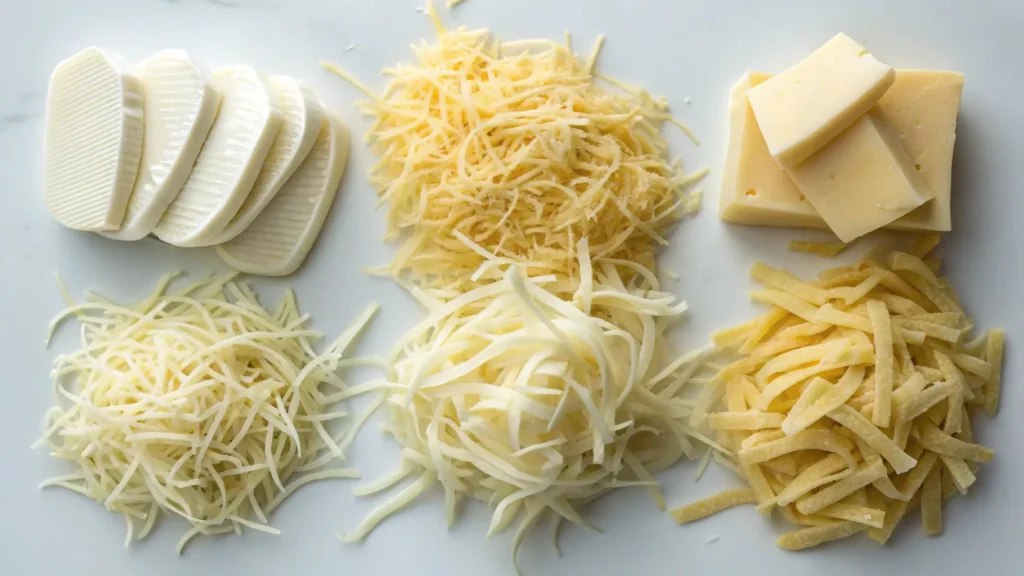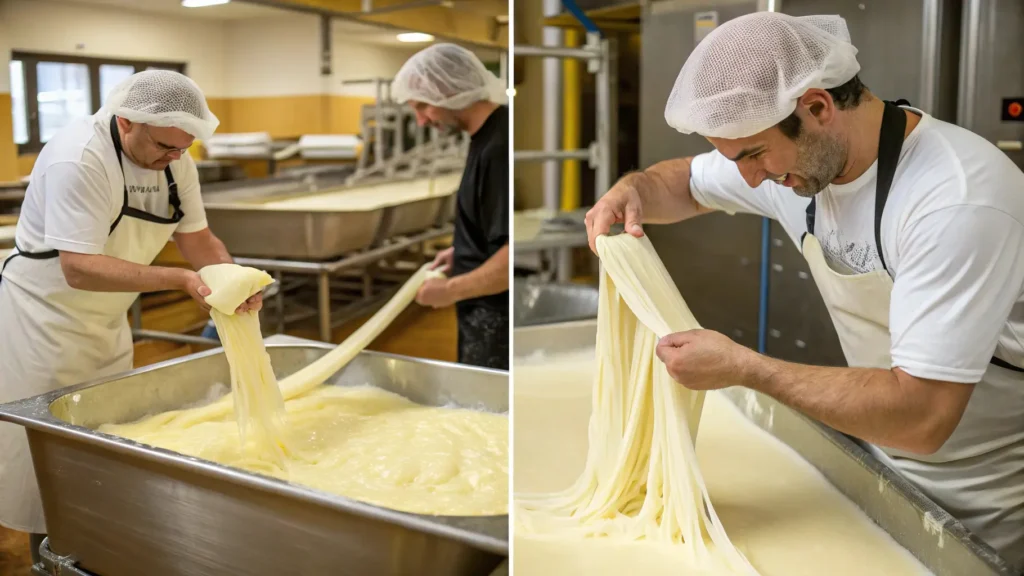Stringy cheese has an undeniable charm. Whether it’s that satisfying pull of gooey mozzarella on a slice of pizza or the fun stretch of a string cheese snack, the allure is universal. This article explores everything about stringy cheese—what it is, why it stretches, its various types, and how it’s made. You’ll also learn about its fascinating global journey and its starring role in some of your favorite dishes. Ready to dive in? Let’s start unraveling the magic of stringy cheese!

Introduction to Stringy Cheese
What Is Stringy Cheese?
Stringy cheese is any cheese known for its elastic texture, allowing it to stretch without breaking. This unique feature makes it a favorite in culinary applications like pizza, cheese sticks, and casseroles. Unlike crumbly or hard cheeses, stringy varieties owe their texture to a specific combination of proteins and preparation techniques.
At its core, stringy cheese is a dairy delight that undergoes a heating and kneading process, creating long strands of stretchy proteins. This makes it fun to eat and visually captivating—a winning combination for cheese lovers worldwide.
Why Does Cheese Become Stringy?
The science behind the stringiness lies in its structure. Certain cheeses contain high levels of casein proteins, which align into strands when heated. This alignment gives them that characteristic “pull.” The type of milk (cow, buffalo, or goat), the acid levels during production, and the stretching process all contribute to the final result.
Not every cheese can stretch—cheddar, for example, is dense and crumbly. However, cheeses like mozzarella and provolone are specially crafted to deliver that melt-in-your-mouth stretchiness that makes them so beloved.
Types of Stringy Cheese

Mozzarella: The Most Famous Stringy Cheese
When people ask, “What is the stringy cheese called?”, mozzarella often tops the list. This Italian classic is famous for its incredible stretch and smooth texture. Traditionally made from buffalo milk, modern mozzarella is more commonly crafted using cow’s milk. Its secret lies in its low-moisture, high-protein composition, which transforms into long, stretchy strands when heated.
Mozzarella is the go-to cheese for pizza, lasagna, and caprese salads. Its mild flavor complements dishes without overpowering them, making it a versatile favorite.
Provolone: The Overlooked Stringy Delight
Provolone may not be as famous as mozzarella, but it holds its own in the world of stretchy cheeses. This semi-hard cheese, originally from southern Italy, offers a richer, slightly tangy flavor profile. Provolone melts beautifully, delivering a satisfying stretch in sandwiches, baked dishes, or even on its own as a snack.
Provolone’s unique aging process adds complexity to its taste, ranging from mild to sharp depending on how long it’s matured. Its adaptability and melting properties make it a hidden gem for cheese enthusiasts.
String Cheese: Snackable and Fun
Who hasn’t enjoyed peeling strands of string cheese? This playful snack is essentially mozzarella, formed into easy-to-handle sticks. Its elasticity makes it perfect for on-the-go munching, especially for kids. Despite its simplicity, string cheese has become a staple in lunchboxes and charcuterie boards alike.
Other Varieties: Cheddar and Beyond
While mozzarella and provolone dominate the stringy cheese world, other varieties like Oaxaca cheese from Mexico and certain types of cheddar also deliver surprising stretches. Oaxaca, for instance, is known as the “Mexican mozzarella” for its comparable texture and flavor. With so many options, it’s clear that stringy cheese offers something for everyone.
Science Behind Stringiness
Role of Proteins and Milk Type
The magic of stringy cheese lies in its proteins—specifically, casein. These proteins form a network of elastic bonds, which align during the heating and kneading process. This is why cheeses like mozzarella stretch effortlessly when melted.
Additionally, the type of milk used plays a crucial role. Cow’s milk and buffalo milk produce different levels of elasticity due to their fat and protein content. For example, buffalo milk mozzarella is creamier and stretches more smoothly compared to its cow milk counterpart.
Effect of Heating and Stretching
Heat is the game-changer when it comes to stringy cheese. As the cheese melts, the proteins unwind and reorganize, forming the long strands we love. Stretching during production further enhances this effect, as it aligns the proteins in a way that encourages elasticity.
Cheeses that don’t stretch, like cheddar or parmesan, have tightly packed protein structures that resist movement. So next time you see a cheese pull in a commercial, remember—it’s all about the science behind the strings!
How Stringy Cheese Is Made

Ingredients Used in the Process
When diving into the question, “What is the stringy cheese called?”, understanding its creation adds a layer of appreciation. The essential ingredients for making stringy cheese include high-quality milk, rennet (an enzyme used to curdle the milk), and a touch of salt for flavor.
The type of milk—cow, buffalo, or goat—plays a significant role in determining the cheese’s texture and flavor. Buffalo milk, for example, gives mozzarella its traditional creamy richness, while cow’s milk creates a slightly firmer texture. Salt not only enhances the taste but also helps in preserving the cheese.
Step-by-Step Production
- Curd Formation: The milk is warmed and combined with rennet to form curds, the building blocks of cheese.
- Heating: Once curds are separated from the whey, they are heated to make them pliable.
- Stretching: The magic happens here! The curds are kneaded and stretched until the proteins align, giving the cheese its signature elasticity.
- Shaping and Cooling: Finally, the cheese is shaped—whether into balls, strings, or blocks—and cooled in water or brine to set its texture.
For more details on crafting delightful cheeses and incorporating them into recipes, check out the Rope Cheese Guide on Tangle Recipes.
Popular Dishes Featuring Stringy Cheese
Pizza: The Ultimate Stringy Cheese Experience
Ask anyone “What is the stringy cheese called?”, and mozzarella’s role in pizza instantly comes to mind. From its gooey stretch on a Neapolitan-style pizza to its bubbling perfection on deep-dish varieties, mozzarella reigns supreme. The way it melts evenly and stretches across a hot slice makes it a pizza essential.
Cheese Sticks and Snacks
Few snacks deliver satisfaction quite like fried cheese sticks. These crispy, golden treats are packed with stretchy mozzarella, offering that irresistible pull with every bite. They’re perfect for parties or as a comforting indulgence.
Casseroles and Comfort Foods
Stringy cheese isn’t just for snacks; it’s a key player in casseroles and baked dishes. Think cheesy lasagna, au gratin potatoes, or baked ziti—dishes where mozzarella or provolone brings a hearty, gooey texture to every serving.
For more recipe inspiration, check out other creative ideas on Tangle Recipes, such as combining cheeses in everyday dishes.
Part 6: Stringy Cheese Around the World
Italian Influence on Stringy Cheese
When considering “What is the stringy cheese called?”, it’s impossible to overlook Italy’s role. Italian cheeses like mozzarella and provolone have set the global standard for stringiness. Mozzarella, in particular, has its roots in southern Italy, where it was originally made with buffalo milk. This cheese became the star of dishes like pizza and lasagna, making it a household name worldwide.
Provolone, another Italian gem, adds a robust flavor to recipes. While less famous than mozzarella, its stretchability makes it ideal for hot sandwiches and baked dishes. Italians have truly perfected the art of making cheese that melts and stretches beautifully.
Global Variations: From Oaxaca to Kashkaval
Stringy cheese isn’t exclusive to Italy. Across the globe, various cultures have their own stretchy delights. In Mexico, Oaxaca cheese is celebrated for its soft, mozzarella-like texture, making it perfect for quesadillas and tacos. Often referred to as “the Mexican mozzarella,” it’s a staple in many Latin American dishes.
In Eastern Europe, kashkaval—a semi-hard cheese—is popular for its mild flavor and melting qualities. It’s often used in savory pastries or melted over roasted vegetables. These regional variations highlight the universal love for stretchy, stringy cheeses across different cuisines.
FAQs About Stringy Cheese
What Makes Mozzarella So Stretchy?
Mozzarella owes its stretchiness to its unique production process. The curds are heated and stretched repeatedly, aligning the proteins to form long, elastic strands. This process is what makes it stand out as the ultimate answer to “What is the stringy cheese called?”
Can All Cheese Be Stringy?
No, not all cheese can be stringy. The structure of a cheese’s proteins determines whether it will stretch. Hard cheeses like parmesan and crumbly ones like feta lack the alignment of proteins needed for elasticity, which is why they don’t melt or stretch in the same way.
Is String Cheese Real Cheese?
Yes, string cheese is real cheese—specifically, it’s usually made from mozzarella. The only difference is in the shape and size, which are designed to make it convenient for snacking. Its natural stretchiness comes from the same process that gives mozzarella its iconic pull.

